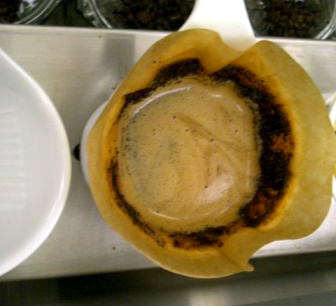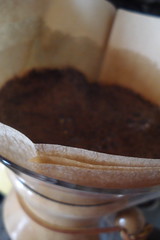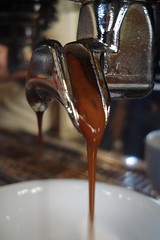Oh, dear. I hurt.
This weekend, the first that Joe Chelsea (or Joe London Terrace, as you prefer) was open for business, I stretched my barista muscles after a long, idle six-month absence from behind the bar. It was a blast: Customers appear to love us, the coffee's great, the space is lovely, the coffee's great, the location is sunny and bright, did I mention the coffee's great?
But boy oh boy, I'm creaky today for sure.
My favorite thing about the new shop (aside from making lattes for neighbor Mario Cantone, on whose children's show I was one featured as a third grader) is the new drip bar.
(Photo by Michael Gitter from opening day, since I still haven't managed to crack my camera when I'm in the shop.)
I previously said that it was designed by the folks at Blue Bottle, using beehouse ceramic drippers. But I neglected to admit that it produces some of the most beautiful coffee I've ever had—probably because I didn't get near it until yesterday morning (don't even ask how busy we were Saturday afternoon). But yes, the coffee I made in that little cone was absolutely exceptional. With every sip something else came out in vibrant waves, all that berry and zest, those lower, tomato-soup type flavors, that clean finish. I felt like I was tasting the very essence of the origin.
Which allows me to go off on an unsolicited tangent.
Were I to open my own coffee shop—which I will likely not—I am beginning to think I'd forgo the espresso machine altogether. Press pots, individual Chemexes, a drip bar, daily cuppings, vacuum pots, cowboy coffee and, yes, a double-brewing Fetco, but no espresso.
Now, here's where I make an unpopular confession. I mean, I love espresso. I've truly and enthusiastically enjoyed shot after shot of it pulled by master baristas who are the top of their game, and I've even been thrilled by a fair percentage of my own pours. I love preparing espresso, and I live to build drinks with it. Teaching people to make it is my favorite thing in the world, and I will excitedly talk for hours with someone about their preferences and techniques.
But I think that while well-made espresso coffee can capture certain nuances and delicacies in a bean, drip-brewed coffee can be so much more accessible and varied, and to to prepare it in the shadow of an espresso machine (from which, let's face it, the bulk of the product is always going to be lattes and cappuccinos) is almost at times to diminish its value in the mind of the customer—not to mention the barista.
Let me stress at "at times."
Perhaps this is a New York or East Coast thing, and specifically perhaps a food-media thing even then, but in the past few years of industry growth out here, the emphasis has fallen squarely on the shoulders of the espresso, of the latte art, of the cool barista behind the Synesso who talks about distribution, grams and atmospheric bars of pressure. It seemed like it wasn't until the early Clover buzz that anyone started paying attention to nonconcentrated brewed coffees, and even then all the fuss was about a machine that essentially speeds up and re-creates extraction methods that have been around forever.
(That is not a back-handed knock on Clover, which does make quickly fresh-brewed single servings accessible in a way that a four-minute press pot can't. More it's an observation about the nature of the attention given to certain extraction methods over others.)
Meanwhile, walk into any of the great shops around here, and you can get a pressed-to-order cup of some of the most beautiful, rightfully expensive, high-quality coffees available in the world today. Where's the media profile about that? Where's the overdue buzz about the several very good and enthusiastic nonprofessional cuppings that happen regularly in and around New York?
I feel like too often drip drinkers are somehow considered secondary to espresso drinkers (or even latte drinkers) because there's something unexotic about getting a straight cup of coffee. Worse, I think it's common for a barista to be conditioned to look down on drip-coffee drinkers by accident or association—sometimes because there is much talk about profit margins, sometimes because of the judgments we place on people who take their coffee "regular," sometimes because we may assume drip-coffee drinkers don't know the difference between Cup of Excellence and Chock full O' Nuts, sometimes because we think it's that drip-coffee drinkers are in a rush and don't want to stand around waxing poetic about 12 ounces of a Guatemalan.
We're almost trained that way unintentionally—especially in a café with a huge brewer and some air pots. Have you ever heard of a shop that doesn't allow one of the baristas to make drip coffee without one-on-one after-hours training sessions? No way—toss it in the grinder, slap it in a filter and you're good to go. Of course no one wants the staff to misunderstand the importance of drip coffee, but we really do tend to kind of write it off in a way, most likely without meaning to.
What do I imagine would happen in a perfect world? Coffee shops that separate the arts as well as ones that marry them: drip-centric locations and pure espresso bars in addition to the hybrids we see everywhere as of now, and everyone bettering the craft of coffee.
What do I think should ideally happen in any specialty-coffee establishment that serves nonconcentrated coffee alongisde espresso? Long, talky sessions with new staff going over every step of every brewing process, and extensive tastings of every coffee on offer prepared using every method employed by the shop.
Is that realistic? Probably not. Do I still think it should happen? Absolutely. Should I shut my yap before I get roped into organizing just such a program myself? Probably!
Anyway, yes. That's my fantasy coffee shop. Also in my fantasy coffee shop, tasting flights of the same coffee brewed three or four different ways. Also also a secret GS/3 in the basement for when I want a shot of Black Cat or Barrington Gold or Hair Bender anyway. Hey, give a girl a break!
Oh, and what would it be called, you ask? The Big Drip!
3/31/08
Nope, it's not like riding a bicycle!
Posted by
Meister
at
10:28 AM
![]()

